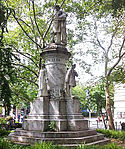Beacon Theatre (New York City)

The Beacon Theatre is an entertainment venue and former movie palace at 2124 Broadway, adjacent to the Hotel Beacon, on the Upper West Side of Manhattan in New York City. Opened in 1929, the Beacon Theatre was developed by Samuel "Roxy" Rothafel and built as a movie palace. It was designed by Walter W. Ahlschlager with decorations inspired by the Renaissance, Ancient Roman, Ancient Greek, and Rococo styles. The Beacon has 2,894 seats across three levels and is operated by Madison Square Garden Entertainment. The theater is designated as a New York City interior landmark and is listed on the National Register of Historic Places. The facade is relatively plain and is made of brick and stone, with a marquee above its entrance on Broadway. The outdoor ticket booth leads to a vestibule and a multi-story rotunda lobby under the hotel, with a mural by Danish artist Valdemar Kjoldgaard in the lobby. The auditorium is in an adjacent structure on the eastern part of the site, near 75th Street and Amsterdam Avenue. The auditorium's side walls have ornate arched doorways and murals, while the multicolored ceiling has a chandelier. The proscenium arch has Greek columns and is flanked by large statues. The orchestra pit has a Wurlitzer organ, one of three in Manhattan. The theater was originally proposed in January 1927 as the Roxy Midway Theatre. Roxy severed his involvement and Warner Bros. took over the theater, opening it on December 24, 1929. The Central Amusement Corporation took over the Beacon in 1932, and Brandt Theatres assumed operation in 1944, running it for three decades. The theater started presenting live entertainment in 1966, and Steven Singer and Barry Kerr renovated it into a rock venue in 1974. After Singer's bankruptcy, Kazuko Hillyer turned the theater into a performing arts center in 1976. Following a failed attempt to convert the Beacon into a nightclub and restaurant in 1986, the theater remained in use as a live music and entertainment venue. MSG Entertainment took over in 2006 and renovated the Beacon shortly afterward. Over the years, the Beacon has hosted numerous concerts; some acts have appeared for extended residencies, including the Allman Brothers Band. It has also hosted other types of live performances, including dance troupes and plays. The Beacon has additionally been used for broadcasts, tapings, films, and ceremonies such as the Tony Awards.
Excerpt from the Wikipedia article Beacon Theatre (New York City) (License: CC BY-SA 3.0, Authors, Images).Beacon Theatre (New York City)
Broadway, New York Manhattan
Geographical coordinates (GPS) Address Nearby Places Show on map
Geographical coordinates (GPS)
| Latitude | Longitude |
|---|---|
| N 40.780472222222 ° | E -73.981138888889 ° |
Address
Broadway 2130
10023 New York, Manhattan
New York, United States
Open on Google Maps







